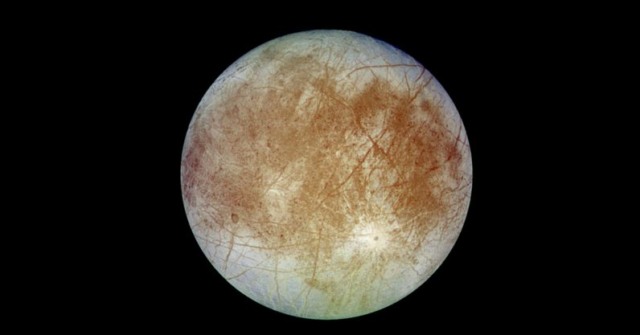Jupiter’s moon Europa glows in the dark which is about as fucking rad as it gets!

Space! What cool fucking reveals do you have for us today? Oh! Jupiter’s moon Europa? It glows in the dark? Whelp, that is indeed fucking cool.
The Next Web:
Laboratory experiments have re-created the surface of Europa, one of the four large moons of Jupiter, with a surprising result — Europa glows in the dark. While we typically see the side of Europa facing Earth, this new study shows what this world might look like from its other side.
This discovery is more than an interesting fact about the Solar System — it reveals secrets of the enigmatic moon.
Europa on the rocks
The icy surface of Europa is rich with salt, including magnesium sulfate (Epsom salt) and sodium chloride (common table salt). Each type of mineral radiates specific wavelengths of light when releasing energy. These studies found that salts within the icy crust of the Jovian moon can glow in the dark.Europa is one of the water worlds of our solar system, holding a vast ocean under its frozen surface.
“[E]uropa’s ice shell is 10 to 15 miles (15 to 25 kilometers) thick, floating on an ocean 40 to 100 miles (60 to 150 kilometers) deep. So while Europa is only one-fourth the diameter of Earth, its ocean may contain twice as much water as all of Earth’s oceans combined,” NASA describes.
Gravitational forces between Europa, Jupiter, and its companions Io and Ganymede create cracks in the frozen surface. In some places, this ocean rises through these cracks in the ice. Therefore, by studying the outer surface of the ice, it is possible to learn about the hidden oceans of Europa.
Europa, one of the four large moons of Jupiter, is home to vast salty oceans. Artist concept based on spacecraft data. Image credit: NASA/JPL
Radiation from Jupiter raises energy levels of salt molecules as the moon makes its way through the planetary system. When these molecules relax, this energy is released as visible light.“These high-energy charged particles, including electrons, interact with the ice- and salt-rich surface, resulting in complex physical and chemical processes,” researchers describe in Nature Astronomy.
As seen by the human eye, the surface of Europa would glow green, blue, and white, depending on the types of salt emitting light. The ice glowed strongest with green light similar to a typical green screen used in movie and video studios (including Astronomy News with The Cosmic Companion).
Higher concentrations of Epsom salt increased the amount of energy released within the ice, while sodium chloride and carbonate had the opposite effect.
As these electrons fall upon the surface of the icy moon, the incoming energy is released in the form of light, creating conditions where Europa glows in the dark.
“If Europa weren’t under this radiation, it would look the way our moon looks to us — dark on the shadowed side,” Gudipati said. “But because it’s bombarded by the radiation from Jupiter, it glows in the dark,” explained Murthy Gudipati of Jet Propulsion Laboratory (JPL).
The JPL team built a unique instrument — the Ice Chamber for Europa’s High-Energy Electron and Radiation Environment Testing (ICE-HEART) — to examine how organic material in a simulated Europa environment would react to radiation.
This discovery was a happy bit of serendipity for researchers.
“Seeing the sodium chloride brine with a significantly lower level of glow was the ‘aha’ moment that changed the course of the research,” said Fred Bateman, co-author of a journal article detailing the study.



